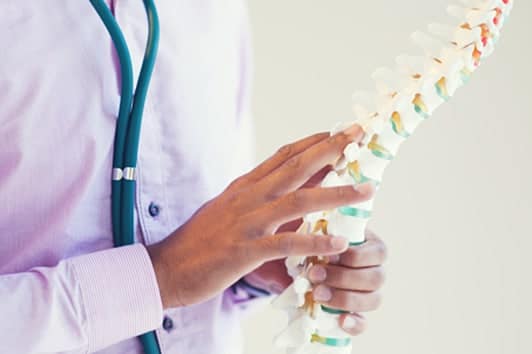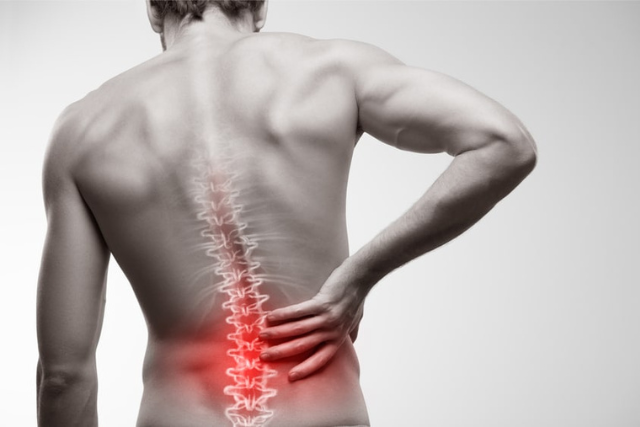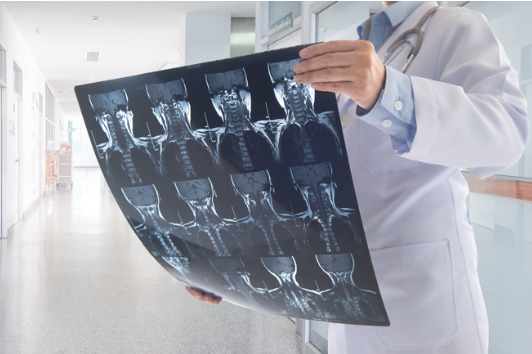Degenerative Disc Disease
Understanding the Symptoms, Causes & Treatments for Degenerative Disc Disease
Reviewed by: Dr. Christopher Good, Dr. Colin Haines, Dr. Ehsan Jazini
What is Degenerative Disc Disease?
Degenerative disc disease is not really a disease, rather it is a term used to describe the normal changes of spinal discs as the aging process advances. Spinal discs are soft and compressible shock absorbers which cushion the bones of the spine. The discs allow the spine to flex, bend, and twist, absorbing the stresses of life and recreational activities, such as lifting weights or running marathons. This degenerative process, or “DDD”, takes place throughout the spine, but most often occurs in the discs of the lower back (lumbar region) and the neck (cervical region).Many patients diagnosed with low back pain, caused by degenerative disc disease, are left wondering exactly what this diagnosis means for them. As we age, our intervertebral discs lose their flexibility, elasticity, and shock-absorbing characteristics. The discs lose water, which is essential for the collagen within the disc space to maintain flexibility. The ligaments which surround the disc space, the annulus fibrosis, become brittle and more easily torn. At the same time, the soft gel-like center of the disc, the nucleus pulposus, starts to thin and shrink. The combination of repetitive damage to the intervertebral disc, the development of bone spurs, and a gradual thickening of the ligaments that support the spine, all can contribute to degenerative arthritis.


What are Common Symptoms of Degenerative Disc Disease?
When someone is suffering with degenerative disc disease their pain generally occurs near the location of the affected disc. An affected disc in the neck area may result in both neck and arm symptoms, while a disc in the lower back may result in pain in the back, buttock, or legs. The pain often becomes worse with movement, such as bending over, reaching up, or twisting and may start with a seemingly trivial injury. Most commonly, pain occurs with prolonged sitting or prolonged standing, such as on a long car trip or an airplane flight.
When Should You Seek Treatment for Degenerative Disc Disease?
If you’re noticing symptoms associated with Degenerative Disc Disease and suspect a spinal issue, it’s crucial to consider consulting a board-certified spinal specialist. Reach out promptly to a certified spine surgeon for an accurate diagnosis and timely treatment. Early intervention can significantly improve your overall well-being and provide a broader range of treatment options, which may decrease as symptoms persist. The key to a successful and speedy recovery lies in addressing the root of the pain with your spine specialist as soon as symptoms arise.
While many people experience day-to-day back or neck pain, dismissing it as soreness, this may not be the case for everyone. If your pain persists for more than 10 days, it should be taken more seriously. Evaluate such prolonged pain with a spine surgeon to identify the root issue and determine the appropriate treatment. Additionally, be attentive to other signs related to back or neck pain that should not be ignored, including pain accompanied by fever, pain associated with loss of bladder control, and weakness/tingling/numbness in your arms or legs.
It’s important to note that these are general guidelines based on our expertise in spine care over the past three decades, recognizing that each patient’s symptoms may be unique.


What are Common Causes of Degenerative Disc Disease?
Degenerative disc disease is a condition that involves weakening of one or more vertebral discs which normally act as a cushion between the vertebrae. This can occur anywhere in the spine. This condition can develop as a natural part of the aging process but may also result from an injury to the back or neck.
Degenerative disc disease typically begins when small tears appear in the disc wall called the annulus. Individual lamellae collagen fibers make up the annulus. Tears in the lamellae are referred to as annular tear or as a ‘torn disc’. When the disc degenerates the disc begins to lose many of its properties that make it a good shock absorber. For some people these tears can cause considerable pain and spasms. Just like other tissues in our bodies, the disc heals over several weeks by creating scar tissue, however scar tissue is not as strong as the original disc wall. Over time, with repeated neck or back injuries, the process of tearing and scarring may weaken the disc wall. As people age, the nucleus pulposus (center of the disc) becomes damaged and loses its water content. This fluid is needed to keep the disc functioning as a shock absorber. If the nucleus pulposus is not able to act as a cushion, the nucleus collapses and the vertebrae above and below the damaged disc slide closer together. This improper alignment causes the facet joints (the areas where the vertebrae touch) to twist due to an unnatural position. In time, this awkward positioning of the vertebrae may create bone spurs. If bone spurs grow into the spinal canal, they may pinch the spinal cord and nerves, a condition called spinal stenosis. If the outer annulus tears and a piece of the nucleus pulposus moves through the tear, a disc herniation may pinch the spinal cord and nerves. The site of the injury may be painful. Some people experience a radiculopathy as pain, numbness, or tingling in the arms or legs.
How is Degenerative Disc Disease Diagnosed?
Diagnosis of degenerative disc disease is made through a detailed history and physical exam. There are many tests that can aid in the diagnosis which include MRI scan, x-rays, CT scan, and discography. Your spine specialist will decide which tests are necessary based on the history, physical examination, and test done to date.


What are Common Treatments for Degenerative Disc Disease?
Treatment of degenerative disc disease initially involves spine-specialized physical therapy. Your physical therapist will be able to provide an individualized treatment program based on your specific symptoms and areas involved. Anti-inflammatory medications can often be useful especially in combination with physical therapy. Should symptoms persist beyond physical therapy, a steroidal injection may be helpful depending on the structure causing pain. Regenerative treatment options may also be discussed with your spinal specialist if symptoms fail non-surgical care. Regenerative options include but are not limited to stem cell therapy, platelet-rich plasma, VIA Disc NP and prolotherapy. Surgery may be necessary if the symptoms persist despite trying non-surgical options, or if there is any worsening numbness or weakness indicating progressive nerve damage.

